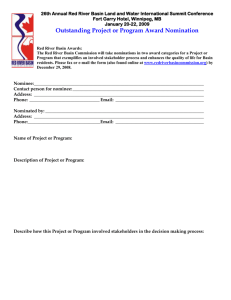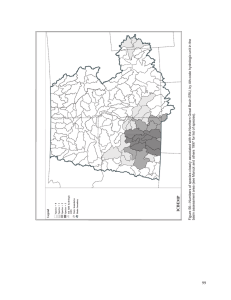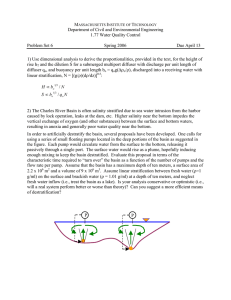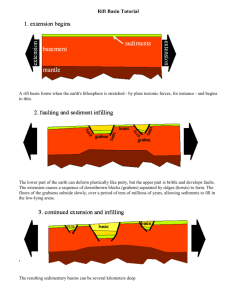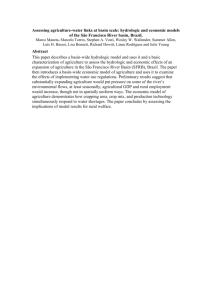K-MODSIM DSS
advertisement
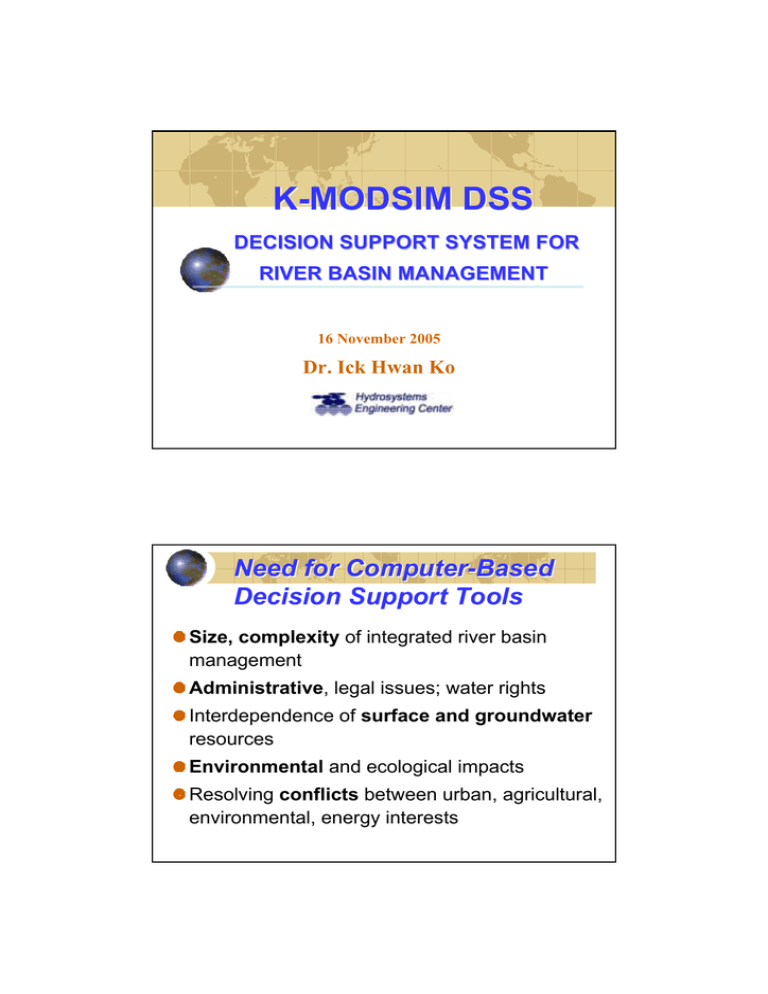
K-MODSIM DSS DECISION SUPPORT SYSTEM FOR RIVER BASIN MANAGEMENT 16 November 2005 Dr. Ick Hwan Ko Need for Computer-Based Decision Support Tools Size, complexity of integrated river basin management Administrative, legal issues; water rights Interdependence of surface and groundwater resources Environmental and ecological impacts Resolving conflicts between urban, agricultural, environmental, energy interests Concept of Decision Support System (DSS) Optimization available in a DSS as a tool under the direct control of reservoir system managers for decision-making purposes Provides “support” for decision makers, rather than overly empowering programmers/modelers Recognizes river basin as an integrated “system” Components of a DSS 1. Dialog Subsystem 2. user/model interaction; usually GUI (graphical user interface) manipulate model--check logic Input data during model execution Data Base Management Subsystem 3. coordination, integration, integrity, storage and extraction of information separation of data and decision models Models Subsystem problem analysis and modeling simulation, optimization, statistical analysis Decision Maker Dialog Subsystem user/model interaction; usually GUI Central Processing Unit Static Database Dynamic Database Data Model Base Base Management Management System System Data Subsystem coordination, integration, integrity, storage and extraction of information Planning Models Management Models Operations/ Control Models Models Subsystem simulation, optimization, statistical analysis K-MODSIM as a DSS Designed as computer-aided tool for developing improved basin-wide and regional strategies for short-term water management long-term operational planning drought contingency planning helping resolve conflicts between urban, agricultural, energy, environmental interests Powerful GUI connects K-MODSIM with data base management system and efficient network flow optimization model Dialog Subsystem user/model interaction; usually GUI manipulate model--check logic Input data during model execution Models Subsystem problem analysis and modeling simulation, optimization, statistical analysis Database Subsystem coordination, integration, integrity, storage and extraction of information separation of data and decision models Objective function and constraints of network flow optimization model automatically constructed through GUI requires no background in optimization or computer programming Optimization used as efficient means of satisfying all system demands/guidecurves according to given priorities… …while assuring water allocated according to physical, hydrological, and institutional/ administrative aspects of river basin management HOW DOES K-MODSIM WORK? Underlying principle-most complex river basin systems can be simulated as capacitated flow networks Capacitated—upper/lower (time variable) bounds on all flows Model Objects: Reservoir (Storage) Nodes Non-Storage Nodes Demand Nodes ( , , ) Links (or Arcs) Physical System Hydrology Physical Network Legal/Institutional Constraints Demand Projections Network Network Representation Representation KK-MODSIM -MODSIM Generalized Generalized River River Basin Basin Network Network Model Model NODES & LINKS Planning/ Operating Strategies Hydrology K-MODSIM Inputs Physical Network K-MODSIM Generalized River Basin Network Flow Model Legal/Institutional Constraints Demand Projections Planning/ Operating Strategies 190,000 Demand (acre-feet per y 170,000 150,000 130,000 110,000 90,000 2040 S1 2031 2034 2037 2022 2025 2028 2010 2013 2016 2019 2001 2004 1998 Year 2007 50,000 1995 70,000 Water Allocated according to: Water Rights Economic Criteria Exchange Mechanisms Storage Accounts and Contracts Complex IF-THEN Operational Rules Instream Flow Requirements Network Flow Approach Network flow models do not need precise economic-based objective functions Objectives in network flow models can be formulated from rankings and water right priorities if available, economic data can be used Simulation structures based on network flow optimization more efficient extremely large networks can be efficiently solved— 1000’s of nodes and links Network Flow Optimization Technically speaking, K-MODSIM is an optimization model BUT, K-MODSIM primarily uses optimization as an efficient mechanism for simulation Minimum cost network flow problem solved iteratively in sequential fashion over time; not fully dynamic (i.e., no presumed foreknowledge of future events) State-of-the-art network flow optimization Up to 2 orders of magnitude faster than best linear programming solvers Network Flow Optimization State-of-the-art network flow optimization algorithm simultaneously assures allocation of water according to: physical • hydrological • institutional …aspects of river basin management • Network flow optimization enhances the ability to simulate complex river basin systems Network Flow Optimization Network Flow Optimization Accounting Nodes and Links When user constructs K-MODSIM network, certain artificial or accounting nodes and links are automatically created (not seen by user): these insure maintenance of mass balance throughout network useful for modeling complex administrative and legal mechanisms governing water allocation Active Storage [1] Flood Storage [2] Inflow Initial Storage plus Inflow 1 Res 1 Reservoir Seepage Spill 2 Div 4 3 DownStrm Channel Loss 3 Irrig Infiltration GW Pumping Demand SP D S Mass Balance Node Total Inflow plus Total Initial Storage M MODified SIMyld (Shafer, 1979) Originally an extension of the SYMYLD network simulation model developed by Texas Water Development Board (1972) MODSIM extensively updated and extended far beyond original structure of SIMYLD (surface water model only) MODSIM now employs much more efficient algorithm based on Lagrangian relaxation SIMYLD and early versions of MODSIM employed outof-kilter method (OKM) for network flow optimization Adaptive K-MODSIM DSS for Real-Time Operation of the Geum River Basin, Korea by: Ick Hwan Ko Korea Water Resources Corporation (KOWACO) Daejeon, South Korea and John W. Labadie, Darrell G. Fontane Department of Civil Engineering Colorado State University Ft. Collins, CO, USA Background of Project Decision Support System developed for daily operations in Geum River Basin, Korea Geum River Basin facing severe conflicts from: instream flow needs vs. traditional water uses drought contingency planning—increasing pressures integrated operation of existing Daechung Dam with new upstream Yongdam project (2001) uncertainties in hydrology and demands priority-based water allocation, with deficit-sharing long time lags—importance of routing for daily operations Geum River Basin, Korea Schematic of Basin Features subbasins trans-basin diversion instream flow instream flow Basin Characteristics High seasonal hydrologic variability monsoon created floods in summer dry periods in fall, winter and spring Basin drainage area: 9,810 km2 Daechung Multipurpose Reservoir storage capacity: 1490 million m3 hydropower generation 196-240 GWh/yr water supply: 1,650 million m3/yr (2001) flood control: draw down reservoir by June 20 of each year Basin Characteristics (cont.) Yongdam Multipurpose Reservoir storage capacity: 815 million m3/yr hydropower generation: 198 GWh/yr water supply: 650 million m3/year (2001) provides transbasin diversion to the Jeonju, Iksan cities for water supply augmentation (2 turbine units: Geum release and Jeonju diversion) increases hydropower generation, but reduces inflow to Daechung enhances instream flow between Yongdam and Daechung for environmental and water quality purposes K-MODSIM DSS for the Geum River Basin K-MODSIM Customization Microsoft .NET Framework implemented on desktop computers operating under MS Windows NT, 2000, XP Freeware--all components developed from native Visual C++.NET and Visual Basic.NET code—no proprietary licensing requirements Customization through embedded vb.NET custom code custom code compiled through free MS .NET Framework users provided access to all key variables and object classes in K-MODSIM K-MODSIM Customization Custom .NET code can be developed for: defining complex operating rules and policies executing external modules such as water quality models allows linkage of K-MODSIM with database management systems providing access to timely data and forecast information for adaptive realtime river basin management K-MODSIM Features Data-driven model complete reliance on user input data and specifications on system features, operational requirements, priorities Examples of Input data • Hydrologic or physical characteristics – Natural runoff flow – amount of demand (mun., ind., agr., etc.) – capacity of facilities related to water • Management Characteristics – Operation strategies – Priorities K-MODSIM Capabilities Monthly, weekly, daily time steps Complex river basin configurations IF-THEN rules not required for priorities looped, bifurcating network topologies georeferenced networks loaded into K-MODSIM from GIS Details of K-MODSIM Development Design and calibrate most appropriate model networks for Geum River basin Both monthly and daily networks required Streamflow routing included in daily network simulation new backrouting procedure implemented for routing time lags exceeding 1 day Calibration Procedure HYDROLOGIC HYDROLOGICOR ORPHYSICAL PHYSICALCALIBRATION CALIBRATION Attempt Attemptto toinfer infermissing missinghydrologic hydrologicinflow inflowdata dataand and system systemlosses losses Dummy Dummysource sourceand andsink sinkterms termsprovide provideinflows inflows or losses where needed to match or losses where needed to matchgaged gagedflows flowsand and historical historicalreservoir reservoirstorage storagelevels levels(highest (highestpriority) priority) Estimated hydrologic gains and losses MANAGEMENT MANAGEMENTCALIBRATION CALIBRATION Historical Historicalstorage storagelevels levelsno nolonger longerused usedas astargets targets Adjust Adjusthydrologic hydrologicstate stateoperating operatingrules rulesand andpriorities priorities until untilsimulated simulatedstorage storagelevels levelsmatch matchhistorical historicallevels levels K-MODSIM (Final Geum Network) Daechung Transbasin diversion Instream Flow Yongdam How Does K-MODSIM Help Basin Water Managers? Generalized, flexible river basin simulation model that performs operational analysis over various time steps Provides accurate description of physical and operational characteristics of basin, including priority-based allocation and deficit-sharing policies Provides innovative backrouting procedure for daily simulation of water allocation How Does K-MODSIM Help Basin Water Managers? .NET custom code allows simulation of a variety of adaptive operational policies, as well as real-time linkage to data base management system Convenient connection to GIS for map-based simulation Value of K-MODSIM in IWRM Basin Water Management Toolkit for Integrated Reservoirs System Operation Tool for Long-term National/Basin Water Plan Common Tool for Conflict Resolution on Basin/Regional Water Allocation considering Efficiency, Equity, and Environmentally Sustainability Management of Complex Water Right System
